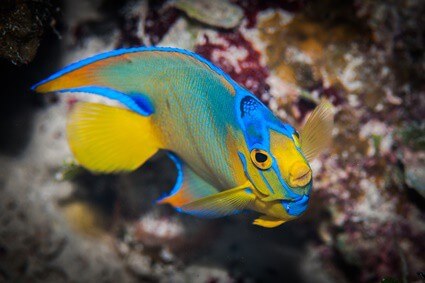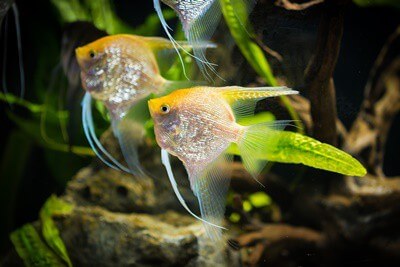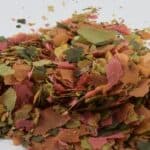Once fin rot takes hold, the bacteria will eat away at the tissue and work into the deeper layers. This will cause the angelfish’s tail and side fins to become ragged, torn, or rotten.
If left untreated, the disease will eventually take over the fish’s entire body. It can also transmit to other fish in the tank, spreading the condition.
If an angelfish gets fin rot, the first step is to quarantine it. Place it in a tank of its own with decorations, and then thoroughly clean the original tank.
Add aquarium salt to both tanks in small amounts and use antibiotics. Maracyn, chloramphenicol, oxytetracycline, and tetracycline are available over-the-counter.
If the infection worsens, a vet can trim away the dead tissue and prescribe stronger medication.
If you want a natural solution, use hydrogen peroxide or Melafix on the diseased angelfish. Keep in mind that this only works for fish that have mild cases of fin rot.
If the severity increases, the fish will be unable to regrow its fins and may die within a few weeks.
What Does Fin Rot Look Like On An Angelfish?
As fin rot gets more serious the longer it continues, note the following warning signs:
- An angelfish with fin rot will have discoloration around the edge of its fins.
- There will become a milky film around the affected areas.
- The corners of the fin will begin to fray and tear.
- Sections of the fin will start falling off.
- The fins will grow bloody, red, and inflamed.
- As the bacteria enter the deeper layers of tissue, the blood vessels will be damaged.
Throughout this process, the angelfish’s immune system will try to fight off the infection.
Since the edges of the fins are raw, they’re vulnerable to secondary infections. Fungal growths like Columnaris may develop. The infection may also spread to other body parts, manifesting as:
- Abdominal swelling.
- Ulcers on its sides.
- Lesions along its underside and back.
According to Seminars in Avian and Exotic Pet Medicine, the damage is due to mycobacterial infections.
Not only will the bacteria open up wounds, but the angelfish may rub against the tank walls or decorations to alleviate its discomfort. Unfortunately, this makes the situation worse.
What Causes Fin Rot in Angelfish?
Bacteria usually cause fin rot. The most common types include:
- Aeromonas.
- Vibrio bacteria.
- Pseudomonas.
Bacteria can grow inside the tank or be introduced to the tank by new fish.
Let’s explore how the angelfish might have got fin rot:
Low Water Quality
If you let the tank water get murky, chemically imbalanced, or thick with algae, this leads to bacterial growth. Unless you’re very experienced with aquariums, you must get a quality filter.
Mechanical, chemical, and biological filtration will sift through contaminants in the water and rebalance the tank. Each week, adjust at least 20-30 liters of the water to minimize nitrate levels.

Fish Overfeeding
Uneaten food will begin to decay in the aquarium, which will increase ammonia and nitrite levels.
This chemical imbalance is where bacteria thrive. Also, the angelfish will have reduced immune function, making it harder to fight off illnesses and diseases like fin rot.
Fluctuating pH Balance And Temperatures
If temperatures are too hot or cold, the fish will become lethargic and weak. The shock to their system can reduce their immune function, opening the door to bacteria.
For angelfish, keep the tank at 78 to 81 degrees Fahrenheit. Very low temperatures cause stress.
Tank Overcrowding
If you’ve just bought a new fish for the aquarium, you may have introduced an infected fish.
All new fish should be quarantined to see if illnesses and diseases manifest. That way, you can treat the sickly angelfish by itself and keep the others safe from harm.
Aside from that, the more fish you have, the easier it is for sickness to propagate. More fish will also result in more waste, which can diminish the tank’s water quality.
Stress Factors
Having colonies of bacteria or fungi in the water is common for an aquarium. Usually, a healthy angelfish can survive or even thrive in the presence of these organisms.
The immune system will be compromised when a fish is stressed, which allows the infection to take hold. Angelfish usually get stressed by the following factors:
- Too much light.
- Too many males in the tank.
- Insufficient hiding places.
- Overfeeding.
- Overcrowding.
- A too-small tank.
Angelfish Fin Rot Treatment
Fin rot will attack the angelfish’s tail and side fins. If the issue isn’t corrected, it can result in permanent damage to the fish’s body, potentially causing death.
Antibiotics can be used in the aquarium to target and destroy the bacteria. The options include:
- Maracyn.
- Maracyn-2.
- Chloramphenicol.
- Oxytetracycline.
- Tetracycline.
These antibiotics have no adverse effects, a high success rate, and are available over the counter.
How To Cure Fin Rot in Angelfish
Don’t just pour antibiotics into the tank. There are certain steps you must take before issuing the antibiotics and aftercare techniques you should follow.
Severity of Fin Rot in Fish
Depending on the severity of fin rot, you may need to vary the dosage of antibiotics. The treatment may also be necessary for longer or be paired with other treatments.
Mild Fin Rot:
- The tattering is moderate.
- The fins are darker in color.
- The redness is mild.
- There are signs of irritation.
Moderate Fin Rot:
- A large part of the fin is rotting and frayed.
- The remaining part of the fin is decolorized and very black.
- There are signs of the fin dying.
- Clumps of the fin slip off when the angelfish is touched or bumped.
Severe Fin Rot:
- A large portion of the fin has rotted or fallen off.
- The fins are bleeding and red.
- There’s significant inflammation.
- The fins are covered in red spots.
- The fins are short or non-existent.
- The fish is showing rot on other parts of the body.
Check for secondary bacterial or fungal infections. These may need to be treated separately and may not be resolved by fin rot medication. For example, a cotton-like growth or bloody patches on the body.
Quarantine All Sick Angelfish
The infection will quickly spread through the tank if allowed to continue. That’s why you have to remove the diseased fish immediately. Put the fish in a new tank on its own.
Ensure the water parameters are balanced and the tank has ample decorations to keep it comfortable.
Clean The Fish Tank
Clean the original tank to limit how much bacteria the other fish are exposed to.
Each day, change 5-10% of the water for a total of 3-6 days. If you change the water too quickly, this may shock the fish and cause them to grow unwell.
Treat the original tank with aquarium salt and check for adverse symptoms. If any issues emerge, you’ll need to use antibiotics on the main tank as well.
Aquarium Salt
When measured correctly, aquarium salt can prevent bacterial and fungal growth. In the quarantine tank, use 1 tablespoon of aquarium salt for every 5 gallons of water.
Blend it in a glass with the tank water before pouring it in so that it’s fully dissolved.
Apply Medication
For the quarantine tank, use antibiotics. Follow the instructions on the label to see how much you need for that tank size, fish, and the symptoms being displayed.
Trim The Affected Fins
If fin rot has worsened, the dead tissue may need to be removed. This should never be undertaken at home unless you have considerable training and experience in performing surgery on fish.
A vet will clean the edges with antiseptic and trim them with sterile scissors once the fish are sedated.
How To Tell Fin Rot Is Getting Better
After 10 days, if treatment is successful, you’ll see the fish:
- Regaining its color.
- Having more energy.
- Healing from the physical damage.
If the angel fish shows negative side effects from the medication or doesn’t appear to recover, contact the vet. Depending on how bad the fin rot is, it may take the angelfish several weeks to fully recover.
How To Treat Fin Rot Naturally
Natural solutions won’t be effective against severe fin rot.
If you identify the sickness early, you can correct the environment and apply milder treatments.
Tank Cleanliness
The cleaner the tank, the fewer bacteria and less likely the angelfish are to get fin rot.
- Clean the tank often.
- Change 5-10% of the water during each session.
- Remove food if the angel fish don’t eat it within 2-3 minutes.
- Ensure the filter is high quality and regularly cleaned.
- Test the water to ensure that the pH level, ammonia, and nitrates are balanced.
If the fish get fin rot, it’s possible their immune system can fight it off if they have clean water.
Aquarium Salt
Saltwater has antiseptic properties that can treat minor fin rot.
However, saltwater angelfish needs the right amount of salt, while freshwater angelfish can be killed when introduced to too much salt.
Only use aquarium salt intended for medicinal purposes and measure it carefully.
Hydrogen Peroxide
If you’re an experienced fish keeper, you can treat an angel’s fin rot by doing the following:
- Catch the fish with a net or a plastic cup with no sharp edges.
- Dip a cotton swab in hydrogen peroxide.
- Dab it on the angel’s rotting fin.
- Return the fish to the tank no more than 30 seconds later.
The fish will grow stressed if kept out of the water for too long.
Peroxide isn’t dangerous to angelfish but can cause minor irritation. Never pour it in the tank or over the fish, as this will disrupt the chemical balance of the water.
Natural Antibiotic
Melafix uses tea tree oil to kill bacteria and repair damage caused by fin rot.
According to the Journal of Exotic Pet Medicine, the positive thing about API Melafix is that it’s safe with no adverse effects. Melafix was found to do the following:
- Impact biological filters.
- Cause water discoloration.
- Change the pH balance.
You can also use methylene blue. Treatment should be applied for a week with regular water changes.
Fast-Growing Plants
Aquarium plants can limit the amount of bacteria and algae that grow wild in your tank.
Add some stable plants to increase oxygen levels, maintain consistent water quality, and give the angelfish somewhere to hide. Plants that grow quickly include:
- Amazon sword.
- Water wisteria.
- Hornwort.
- Green foxtail.
- Java moss.
How Long Does Fin Rot Take To Heal?
How long it takes angelfish to heal depends on the severity. It should take a few weeks to recover if you follow the instructions that come with the antibiotics.
Once the disease is gone, healing takes 4 to 5 days. Recovery from serious fin rot takes 5 to 7 weeks.

Can Fin Rot Kill Angelfish?
If left untreated, fin rot will kill angelfish.
If you notice the symptoms, you should respond immediately. Once the infection has gotten out of hand and escalated to the late stages, the angel’s life expectancy will be just weeks.
Is Fin Rot Contagious?
Fin rot is highly infectious and can spread throughout an entire tank.
Since gram-negative bacteria cause it, it creates a slimy coating on your fish. This outer membrane can easily leech into the water and stick to other fish.
Since angelfish are known to viciously defend their territory, a sickly angelfish might also rub the bacteria off on its tank mates during any conflict.
If the bacteria multiply, the contaminated water will even make your filter a carrier of the disease.
The sponges or collection cups will harbor the fin rot disease and spread it to the water, even once you’ve cleaned the tank. If you notice fin rot in the tank, clean the entire area.
Can Angelfish Regrow Fins?
If the fish is healthy and recovering, it may regrow parts of its fins.
The tail and side fins closely resemble flesh, with layers of skin covering bony spines. These can regenerate over 4-6 weeks, with smaller parts growing faster than bigger parts.
If the fish has entirely lost its fins, it can’t regrow them. The blood vessels, nerves, and tissue will be so damaged that they can’t recover.
How To Prevent Fin Rot
Although fin rot is a common disease, it can be prevented and handled. According to Fisheries Science And Aquaculture, environmental issues and stress are the leading causes.
If you keep the tank well-balanced and help the fish avoid conflict, they’re less likely to get fin rot.
- Clean the tank once a week, changing 20-30% of the water.
- Check and balance the pH level of the aquarium.
- If you want more fish, get a larger tank. Angelfish are most comfortable in 55 gallons or more.
- Avoid overfeeding the angelfish because they may become constipated and ill.
- Remove food that isn’t eaten within 2 minutes.
- Separate fish that bite at each other’s fins and tails because this can create an open wound that bacteria will infect.
Quarantine the diseased fish, use antibiotics, and monitor the other fish in the tank.







